
Bandoneón Tutorial: The Inicial 1
In this bandoneón tutorial I explain the first of a series of preparatory exercises. After having dedicated a series of videos to the fundamental aspects
Who starts to play the bandoneon has to take a first important choice: bisonoric or unisonoric? These are two different keyboard settings, each with its own pros and cons.
The choice of the keyboards’ layout at an early stage does not affect very much the repertoire and the technical possibilities, but the choice of unisonoric can be unhappy when you advance in the technique and face complex repertoires. I have not direct experience on the unisonoric so I trust the experience of those who know both systems, like Fabio Furia.
In this article I analyze the characteristics of the two layouts, without, however, deciding on a winner: each will choose according to his/her preferences. The article is divided into 5 sections:
The term “bisonoric” refers to those bandoneons where by pressing the same key you have two different sounds depending on whether you open or close the bellows. This term usually indicates the 142 Rheinische Tonlage, but it’s not the only one (see in insight).
The unisonoric bandoneon indicates an instrument that produces the same sound opening or closing. This term usually refers to the Peguri (but it’s not the only one – see in insight).
We also refer to the bisonoric bandoneon as the diatonic and to the unisonoric bandoneon as the chromatic. These terms are widespread but inappropriate, as often give rise to misunderstandings. Let’s say that both bandoneons are “chromatic” in the sense that they have the full chromatic scale and on more octaves, but the unisonoric bandoneon is called “chromatic” because the keyboards have a serial chromatic logic.
The word diatonic suggests an instrument capable of playing only in certain tonalities (such as a diatonic accordion) but that’s not the case. The diatonic bandoneon has complete chromatic scales on both sides, but the keyboards don’t follow a serial logic.
The bisonoric bandoneon, with its “chaotic” layout and the different sound depending by the bellows’ direction has its strengths in its defects, these “defects” represent two advantages respect to the bisonoric, once you master the keyboards.
The bisonoric bandoneon is recommended for those who can dedicate time and effort to get familiar with the 2 keyboards. Who needs to play quickly should consider the unisonoric.
Once you master the keyboards the bisonoric is a happy choice, especially for those who play the bandoneon solo repertoire. In fact, that “chaotic” keyboard is very ergonomic to be played with the hand “trapped” by a belt.
Here are the advantages of the unisonoric.
The unisonoric is recommended for those who need to play within a short time, for example a professional that needs to quickly set up a program and then make gigs or concerts. As a matter of fact, many accordion players approach the bandoneon in this way.
Fabio Furia is an Italian bandoneon player who played for ten years the unisonoric and then decided to change for the bisonoric. He has a consolidated experience on both systems.
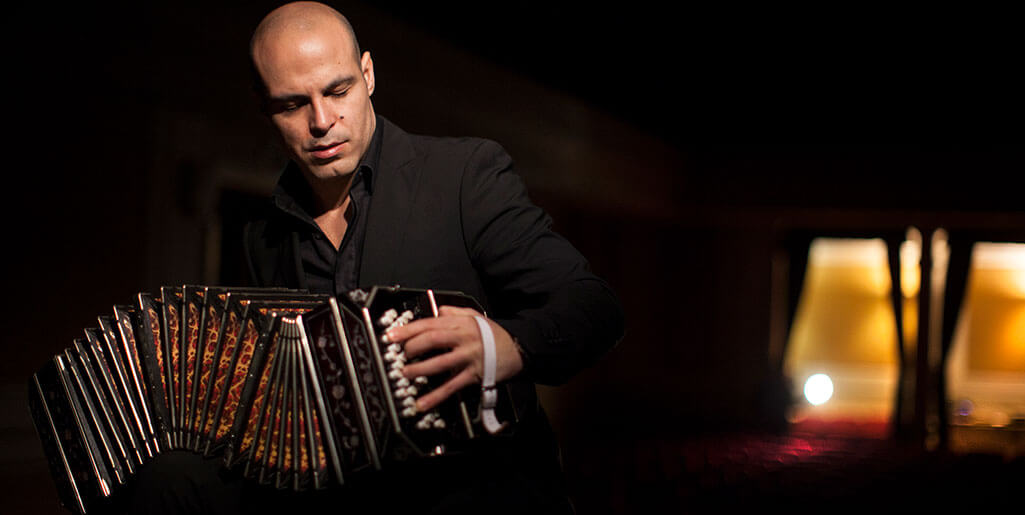
I asked him what he thinks about the unisonoric. Here is his answer:
I’ve been playing the unisonoric for 10 years and I can say that generally you can do the same things you could do with the bisonoric, but not in the same way nor with the same results.
I changed system because the compromises I had to accept were too many and the initial choice of a “logic” keyboard was no longer justified.
The unisonoric gives many problems because of its non ergonomic concept. The serial chromatic keyboard is not suitable to be played by a hand blocked by a strap, and it would be like blocking the hand of a pianist that should move freely on the keyboard.
In fact, the arrangement of the semitones in the high range does not allow you to play with comfort: the instrument is quite comfortable only in a specific region of the keyboard, but just 20-30 keys throughout the instrument.
In my opinion the chromatic bandoneon is the ideal instrument for those musicians who want to play a limited bandoneon repertoire without spending years to memorize the chaotic bisonoric’s keyboards. However, should be clear that the whole repertoire for bandoneon solo is hardly accessible with the unisonoric, and achieving acceptable results requires an effort that no longer justifies the initial assumption: “the logical keyboard is easier”.
There are many great virtuosos of the chromatic bandoneon, but if you listen to them you notice they had to accept compromises or change things: from a technical point of view it’s really hard to get a real legato and some passages are not fluid. That’s because it’s not really the right instrument in that sense.
So what should be easier eventually becomes more complicated.
There are bandoneon players who can do incredible things both with the diatonic and with the chromatic and this leads me to conclude that the keyboard you choose is relatively important: in fact the heart of bandoneon’s technique consists of the bellows’ management. The choice of the keyboard is personal.
I don’t have direct experience on the unisonoric so I think that the point of view of those who know both systems (like Fabio Furia) should be taken into account.
Before concluding the article I’d like to debunk some false myth.
The sound of unisonoric is different from the bisonoric.
False. The sound is pretty much the same. You can detect imperceptible harmonics only with a frequency analysis.
The real bandoneon is the bisonoric one.
False. There are more than 60 different keyboards’ layouts for bandoneon: which is the “true” one? This rumour is really meaningless.
The real bandoneon for tango is the bisonoric one.
False. It’s just a cultural heritage, because in Argentina the only accepted model was the 142 Rheinische Tonlage. You can play excellent tango even with the unisonoric, and many bandoneon players can prove it.
All existing methods for bandoneon are written for the bisonoric.
Partially true. The main methods are written for 142, but you know what? You can change the fingers options.
It’s common to think that exist only 2 kinds of bandoneon, the unisonoric and the bisonoric, and that exist just one kind of bisonoric and one kind of unisonoric.
As a matter of fact, who says “unisonoric” (or chromatic) generally refers to the Peguri systems, and those who talk about the “diatonic” (or diatonic) refer to the 142 Rheinische Tonlage.
Actually exist more than 60 different keyboard schemes: unisonoric, bisonoric, with serial logic, “chaotic”, imitating the piano, the accordion and so on.
The Kusserow system is a unisonoric bandoneon with chromatic layout.
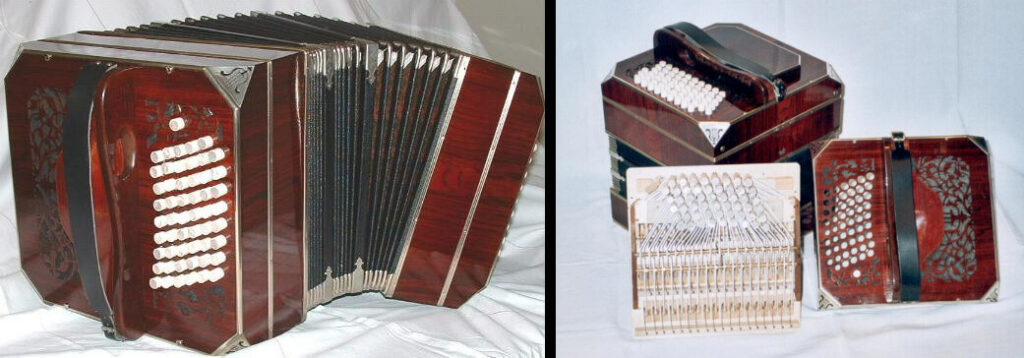
But there is also a unisonoric bandoneon with “chaotic” layout, the Standard bandonion by Heinz Schlegel.
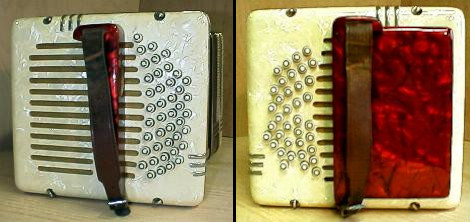
There are several types of bisonoric bandoneons too. The 142 is not the only one. For example, you have the 144 Einheits bandonion, the instrument that I played for maany years and that in the past had important virtuosos, even a jazz bandoneon pioneer in Europe in the 1930s.

These are only the most significant examples, but the list could continue.
At last, I wish to share with you the keyboard layout for the chromatic bandoneons and the keyboard layout for the 142 Rheinische system.

In this bandoneón tutorial I explain the first of a series of preparatory exercises. After having dedicated a series of videos to the fundamental aspects

Learn about chromatic bandoneons! Download FREE PDF keyboard layouts for Peguri, Manoury, & Crosio-Caliero systems. Unisonoric bandoneon explained for beginners.
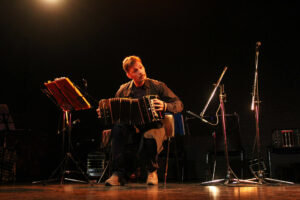
A Lesson from the Bandoneon to Move from Stage Panic to Expressiveness 2024 is coming to an end and I have been very busy during
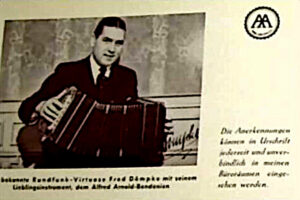
Who is Fred Dömpke and why should deserve more consideration among the bandoneon players? The bandoneon is conquering a significant role in jazz. Many bandoneon

The Bandoneon Price depends on the type of Bandoneon you want to buy. The equation is simple: if you want to learn to play the

Discussing Bandoneon Making with Baltazar Estol A few years ago I saw a video by M. Rodolfo Daluisio playing a bandoneon built by Baltazar Estol.
2 Comments
An interesting and balanced article! It is true that all bandonions with C/B fingering and narrow hand straps cause problems when playing legato melodies, especially in the upper manual range. The hybrid bandonion, which was specially developed to eliminate these problems, confirms this: https://bandonioninfo.de/en/solo,hybrid.htm
The C/B fingering was designed for the Viennese Schrammel harmonica with a free-moving and slightly slanted hand position, neither of which is the case with the bandonion: https://bandonioninfo.de/en/solo,345.htm
However, the limitation of Péguri should not be generalised to all unisonoric bandonions. The Kusserow, with its continuous chromatic tone sequence as on the piano, does not have these problems. It was even developed specifically for classical, polyphonic music: https://bandonioninfo.de/en/solo,kusserow-spende.htm
The Birken bandonion with Janko similiar whole tone rows is also free of the problems of the Péguri: https://bandonioninfo.de/en/solo,birken.htm
Musical greetings from Germany!
H. M.
In additon, there is now an interesting interview with musician Bernd Machus, once a pupil of Ernst Kusserow. The Kusserow bandonion 76 years in test in practice: https://bandonioninfo.de/en/kusserow-machus.htm (see also his playing instructions video: https://www.youtube.com/watch?v=CXcRjLx210Y
(A correction in the first entry: “It was even developed specifically for…” is an exaggeration of the translator. It has to be precise: It was also designed for music…